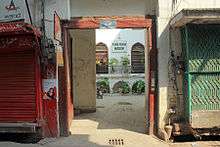Fakir Khana
Fakir Khana (Urdu: فقیر خانہ) is a private museum and house located in Lahore, Pakistan, owned by the Fakir family. Fakhir Khana contains over 20,000 objects, and is the largest privately owned museum in South Asia.[1][2]

Location
The museum is located within Lahore's Walled City, along the Hakimaan Bazaar, near the Bhati Gate.
Background
The Fakir family settled in Lahore around 1730, and established a publishing house.[2] Their status in Lahore society derived from its connections to the Sikh Empire - three of the family's ancestors, Fakir Nooruddin, Fakir Azizuddin, and Fakir Imamuddin, served as emissaries to Maharaja Ranjit Singh.[2] The family amassed a collection of objects, including many bestowed to the family by Ranjit Singh.[2] The family opened their house as a museum open to the public in 1901,[3] and the site receives some government funds for its maintenance.[4]
Collection
The museum's collection consists of approximately 20,000 pieces of art and artifacts mostly from the 18th to 20th centuries,[3] including a small collection of Gandharan artifacts.[3] The collection also contains numerous gifts bestowed to the Fakir family by Ranjit Singh,[2] as well as 10,000 manuscripts, 180 displayed miniature paintings, Sikh era textiles, statuary, pottery, and carved ivory pieces.[2] The collection also includes a 12 by 6 inch painting of Nawab Mumtaz Ali, that was painted with a single hair and required 15 years to be completed.[3]
House
The house in which the museum is located offers insight into the lifestyles of upper class Lahori families during the Sikh and British eras.[3] It was originally owned by Raja Todar Mal, finance minister to the Mughal Emperor Akbar.[3]
References
- "Fakir Khana Museum". Google Arts & Culture. Retrieved 9 October 2017.
- Tariq, Saman (February 2016). "A Visit to the Fakir Khana". Tanqeed Magazine. Retrieved 9 October 2017.
- "Fakir Khana Museum". Google Arts & Culture. Retrieved 9 October 2017.
- Bhatti, Shaila (2016). Translating Museums: A Counterhistory of South Asian Museology. Routledge. Retrieved 9 October 2017.
External links
| Wikimedia Commons has media related to Fakir Khana Museum, Lahore. |